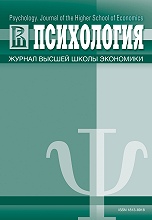How to Measure Perceived Political Efficacy? A Three-Component Scale
Abstract
The aim of this study is to develop and examine a scale that measures three components of perceived political efficacy: personal, collective and external. Twelve statements were formulated based on four abilities: 1) ability to influence the enactment of new laws and political decisions, 2) ability to facilitate the election of a political leader, 3) ability to demand that existing laws and political decisions be observed and 4) ability to express any political opinions freely and publicly. Data was collected online via social media from Russian, Kazakh and Ukrainian samples (N = 2,184) between 2015 and 2017. The scale’s structural validity was tested using confirmatory factor analysis. Results showed that with some modification the short version of the proposed model exhibits good fit indexes across all samples. Configural, metric and scalar invariance of the short version of the Perceived Political Efficacy Scale was also successfully tested. Additionally, differences in political efficacy between certain age groups were discovered, as well as between countries. Namely, people in the 30+ age bracket exhibited higher political efficacy than those in the 18–19 age bracket. Ukrainian respondents showed significantly higher personal and collective efficacy when compared to Russian and Kazakh respondents. Kazakh respondents exhibited the highest level of external efficacy.
Downloads
References
2. Arens, A. K., & Watermann, R. (2017). Political efficacy in adolescence: Development, gender differences, and outcome relations. Developmental Psychology, 53(5), 933-948.
3. Bandura, A. (1977). Self-efficacy: Toward a unifying theory of behavioral change. Psychological Review, 84, 191-215.
4. Bandura, A. (1997). Self-efficacy: The exercise of control. London: W.H. Freeman.
5. Blackwood, L. M., & Louis, W. R. (2012). If it matters for the group then it matters to me: Collective action outcomes for seasoned activists. British Journal of Social Psychology, 51, 72-92.
6. Cakal, H., Hewstone, M., Schwar, G., & Heath, A. (2011). An investigation of the social identity model of collective action and the "sedative" effect of intergroup contact among Black and White students in South Africa. British Journal of Social Psychology, 50, 606-627.
7. Campbell, A., Gurin, G., & Miller, W. (1954). The voter decides. Evanston, IL: Row, Peterson.
8. Caprara, G., & Vecchione, M. (2017). Personalizing politics and realizing democracy. New York: Oxford University Press.
9. Caprara, G. V., Vecchione, M., Capanna, C., & Mebane, M. (2009). Perceived political self-efficacy: theory, assessment, and applications. European Journal of Social Psychology, 39, 1002-1020.
10. Cohen-Chen, S., Halperin, E., Porat, R., & Bar-Tal, D. (2014). The differential effects of hope and fear on information processing in intractable conflict. Journal of Social and Political Psychology, 2, 11-30.
11. Gradirovski, S., & Esipova, N. (2008, 1 August). Russian language enjoying a boost in Post-Soviet states. Retrieved from http://news.gallup.com/poll/109228/Russian-Language-Enjoying-BoostPostSoviet-States.aspx
12. Harder, J., & Krosnick, J. A. (2008). Why do people vote? A psychological analysis of the causes of voter turnout. Journal of Social Issues, 64, 525-549.
13. Heiss, R., & Matthes, J. (2016). Mobilizing for some: The effects of politicians' participatory Facebook posts on young people's political efficacy. Journal of Media Psychology: Theories, Methods, and Applications, 28(3), 123-135.
14. Kenski, K., & Stroud, N. J. (2006). Connections between Internet use and political efficacy, knowledge, and participation. Journal of Broadcasting and Electronic Media, 50, 173-192.
15. Klandermans, B. (1984). Mobilization and participation: Social-psychological expansions of resource mobilization theory. American Sociological Review, 49, 583-600.
16. Klandermans, B. (2008). Embeddedness and Identity: How immigrants turn grievances into action. American Sociological Review, 73, 992-1012.
17. Lee, K. M. (2006). Effects of Internet use on college students' political efficacy. Cyberpsychology and Behavior, 9, 415-422. Madsen, D. (1987). Political self-efficacy tested. American Political Science Review, 81(2), 571-582.
18. Mannarini, T., Roccato, M., Fedi, A., & Rovere, A. (2009). Six factors fostering protest: Predicting participation in locally unwanted land uses movements. Political Psychology, 30, 895-920.
19. Morrell, M. E. (2005). Deliberation, democratic decision-making and internal political efficacy. Political Behavior, 27, 49-69.
20. Mummendey, A., Kessler, T., Klink, A., & Mielke, R. (1999). Strategies to cope with negative social identity: Predictions by social identity theory and relative deprivation theory. Journal of Personality and Social Psychology, 76, 229-245.
21. Niemi, R. G., Craig, S. C., & Mattei, F. (1991). Measuring internal political efficacy in the 1988 National Election Study. American Political Science Review, 85(4), 1407-1413.
22. Rees, J. H., & Bamberg, S. (2014). Climate protection needs societal change: Determinants of intention to participate in collective climate action. European Journal of Social Psychology, 44, 466-473.
23. Schulz, W. (2005). Political efficacy and expected political participation among lower and upper secondary students. A comparative analysis with data from the IEA Civic Education Study. Retrieved from http://iccs.acer.edu.au/uploads/File/papers/ECPR2005_SchulzW_EfficacyParticipation.pdf
24. Tausch, N., & Becker, J. C. (2013). Emotional reactions to success and failure of collective action as predictors of future action intentions: A longitudinal investigation in the context of student protests in Germany. British Journal of Social Psychology, 52, 525-542.
25. Van Stekelenburg, J., & Klandermans, B. (2010). The social psychology of protest. Retrieved from http://www.surrey.ac.uk/politics/research/researchareasofstaff/isppsummeracademy/instructors/Social%20Psychology%20of%20Protest,%20Van%20Stekelenburg%20&%20Klandermans.Pdf
26. Van Zomeren, M., Leach, C. W., & Spears, R. (2010). Does group efficacy increase group identification? Resolving their paradoxical relationship. Journal of Experimental Social Psychology, 46, 1055-1060.
27. Van Zomeren, M., Postmes, T., & Spears, R. (2008). Toward an integrative social identity model of collective action: A quantitative research synthesis of three socio-psychological perspectives. Psychological Bulletin, 134(4), 504-535.
28. Van Zomeren, M., Saguy, T., & Schellhaas, F. M. H. (2012). Believing in "making a difference" to collective efforts: Participative efficacy beliefs as a unique predictor of collective action. Group Processes and Intergroup Relations, 16, 618-634.
29. Zimmerman, M. A. (1989). The relationship between political efficacy and citizen participation: construct validation studies. Journal of Personality Assessment, 53(3), 554-566.





